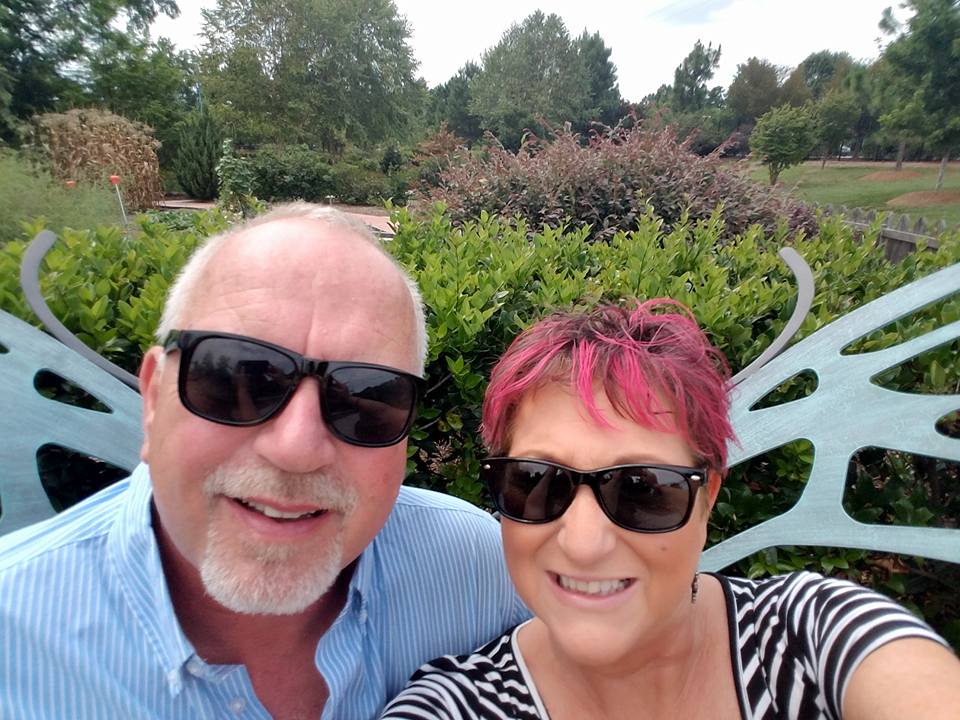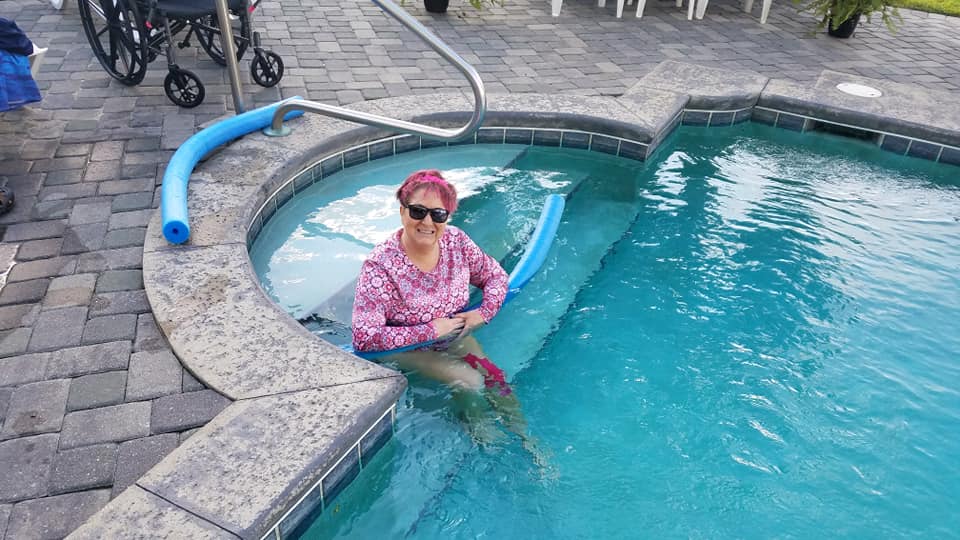Written by Carrie Cleary for the RSDSA blog.
 I had my first spine surgery, a laminectomy in 2008, at the age of 45. That was followed by a multi-level fusion in 2009. This is where we believed the CRPS started.
I had my first spine surgery, a laminectomy in 2008, at the age of 45. That was followed by a multi-level fusion in 2009. This is where we believed the CRPS started.
I had two cervical spine fusions a few years after this. I had nerve blocks for the lumbar nerves every three months for years. After years of pain on and off then just on, I had a Spinal Cord Stimulator implanted in 2016. I was still taking opioids and living in Northern Illinois where the barometric pressure changes and months of bitter cold were killing me. Barometric pressure changes cause the tissues in your body to swell and push on nerves. My docs told me I had to move south or I was going to be crippled. So after a lot of research, my husband and I moved to Pinehurst, North Carolina.
We moved in 2018 and in 2019 I was again having horrible lower back pain that radiated down my left leg. We went up to Duke University Spine Center where after months of tests they did a full spine myelogram and found that L4 & L3 were popping out in opposite directions. I underwent fusion surgery 6/18/19. I woke up and I was paralyzed in my left leg! I was terrified! They went back in again that night but could not fix it. The L4 nerve was damaged after being pinched and would have to regenerate.
I could not feel my leg. And THEN on the 5th day, nerve pain started. I explained it to people that it felt like my skin was being peeled back and fire ants with little knives were on top!! NEVER in my life have I felt anything like this! They had to drug me up to the point I could not hold a conversation for 12 hours to get it under control.
Two days later I was taken by ambulance to an Inpatient Rehab Center in a hospital in Pinehurst. The pain in my leg would get worse at night and I would fear 6:00 pm. I could not sleep for days. Nurses would put a desensitizing cream on my leg and I would scream! We tried ice and heat. I could not even handle any sheets or blankets on my leg. Everything was crazy painful. Thankfully it was summer and I just wore shorts. There at PT & OT I learned to get into bed while using my good leg to lift my paralyzed one, get to the toilet safely and sit down using grab bars, take a shower & learn how to step into it (I use a shower chair), get myself dressed & how to get in a car from my wheelchair. The walker was only used for a few steps, while concentrating on clenching butt muscles because my knee was hyper-extending, meaning bending backwards. The nerve that is damaged controls the muscles in my left leg. When the nerve cannot send messages to the muscles, you have to learn to control those muscles a different way.
My surgeon said I would heal in six months and I thought he was crazy. I am now at five months and they have changed it to one year.
Since I have CRPS/RSD on top of this horrific injury, I have burning, stinging and aching in my lower leg and knee due to both. I am very concerned that this pain will only diminish a little and I will have to live with most of this. When you touch the surface of the inside of my calf, I can’t really feel it. I had a filament test done and when they touched the inside of the calf and I could not feel it. That is a concern, as you need to feel it in order to not hurt yourself.
I started having Biofeedback with a Pain Psychiatrist at Duke. Some of the things she has taught me could benefit many on this blog.
- Keeping your surface body temperature at 88° is very important to help the tissues in my leg.
- Getting enough sleep is very essential. The body needs 6.5 continuous hours of sleep to relieve the brain of toxins it accumulates during the day. This will help memory.
- Chronic pain increases susceptibility for infection. Get your flu shots & wear a mask in doctor offices.
- Nutrition is very important. Eliminate items that cause inflammation such as sugar, dairy & red sauce/cooked tomatoes from your diet.
- Moderate exercise is also needed. Working out in water does wonders for many.
 This is a regular day where I have PT: I set an alarm on my phone for all of my meds. 1 a.m. pain meds, 5 a.m. nerve meds & a muscle relaxer, 7 a.m. pain meds and I get up. I get my coffee and then get in the shower, using the shower chair. I get out and have an additional towel sitting on my rollator walker. I sit on that at a vanity table I had to buy in order to put on my make-up. Then I go back in the bathroom and blow dry and style my hair while sitting on the walker. I am already pretty exhausted. I carefully pick out clothes as my leg is so sensitive so I can only wear a few things. Once it got a little colder here, I bought some Sonoma brand lounge pants at Kohls. I also bought Cuddl Duds (they also make sheets!) & Simply Vera pajamas and a few lounge pants that are super soft. You have to go touch things and cannot order online because only the softest stuff cuts it. At 9 a.m. I take a handful of vitamins and maintenance drugs as my immune system is compromised from the chronic pain. This is not unusual for CRPS patients. I drink a protein shake and head to PT with my wheelchair by 10 a.m.
This is a regular day where I have PT: I set an alarm on my phone for all of my meds. 1 a.m. pain meds, 5 a.m. nerve meds & a muscle relaxer, 7 a.m. pain meds and I get up. I get my coffee and then get in the shower, using the shower chair. I get out and have an additional towel sitting on my rollator walker. I sit on that at a vanity table I had to buy in order to put on my make-up. Then I go back in the bathroom and blow dry and style my hair while sitting on the walker. I am already pretty exhausted. I carefully pick out clothes as my leg is so sensitive so I can only wear a few things. Once it got a little colder here, I bought some Sonoma brand lounge pants at Kohls. I also bought Cuddl Duds (they also make sheets!) & Simply Vera pajamas and a few lounge pants that are super soft. You have to go touch things and cannot order online because only the softest stuff cuts it. At 9 a.m. I take a handful of vitamins and maintenance drugs as my immune system is compromised from the chronic pain. This is not unusual for CRPS patients. I drink a protein shake and head to PT with my wheelchair by 10 a.m.
I’m very lucky that my Physical Therapist, Brent, totally gets my issues. I started seeing him right after we moved here. I can’t stress enough how much PT is important for all of us. Before surgery, he did dry needling, which is trigger point therapy. I have also had Myofascial Physical Therapy which I HIGHLY recommend. Brent now helps me with stretching, mobilizing techniques, stationery recumbent bike, sit & stand core exercises, cupping, Kinesis tape, balance work and walking exercises. Without him, I would not be mobile at all. I go three times a week, which I know is a lot, but so important right now.
After PT, I go home and have lunch and a nap. I like to use the heating pad on my leg to help the discomfort. I take pain meds again at 1 p.m. If I am having a bad day, I go back to bed for up to four hours. Sometimes I sleep through the pain or I read & watch TV. I have a blanket support at the foot of my bed to keep the blanket weight off of my feet. I also have jersey sheets that feel like a soft t-shirt because my leg is so sensitive. Other days I try to assist my husband with chores. I also spend a lot of time reading in my recliner. I have the kind that can stand you up. It also has heat. I purchased a Drive brand medical kitchen chair from Bed, Bath & Beyond as well. This allows me to sit at the counter or in front of the sink or stove. I used to love to cook but it is very difficult now. I try to make soup in a big pot that I can freeze in portions. By cooking your own food, you know exactly what is in it and more importantly, what isn’t. I try to put Turmeric, to reduce inflammation, in almost everything. It may take me all day to do it, but it is helpful. At 7 p.m. I take pain meds and nerve meds and at 9 p.m. I take an anti-depressant that is also for nerve pain.
I live in a 55+ community. People wondered why I moved here so young but we reduced our house size drastically. It is a one level and all outside work is done by HOA. It is not as nice as our old house, but it is making our lives so much easier. We also have many activities here that I can attend. They usually only last a few hours. It is so important to socialize even if you are not 100%, because truly most of us will never be that again. If I am at 60%, I am happy right now.
Having a support system is EVERYTHING. It may be us in this group, your family or friends. I was working as an accountant up until this last surgery. I do not know that I will ever be back full-time again. I have applied for social security disability.
I frequently have people that ask me when I am going to be out of this wheelchair or when am I going to get better. Would you ask a cancer patient that? Heck no! But remember, it is not your job to explain your diagnosis or situation to anyone. We are lifers in this together. But we can share our stories and methods of functioning so we can learn from each other. You never stop learning and should never stop trying alternative methods. It is never going to be just the pills that get us by. Keep an eye out for studies and keep reading these blogs for new ideas and suggestions. Try to keep an optimistic attitude. If you are depressed, which many of us are, see a doctor and get on some medications. Trust me. They help.
Carrie is a 56-year-old woman now living in Pinehurst, NC, after relocating from Northern Illinois. She lives with her husband, Mike, and their cat, Puck. She is an avid Chicago Blackhawks fan and she enjoys socializing with friends, reading, traveling & cooking.
Please consider making a donation to RSDSA today!
